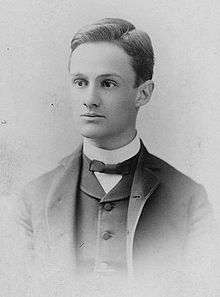William Romaine Newbold
William Romaine Newbold (November 20, 1865 – September 8, 1926) was an American philosopher who held the Adam Seybert Professor of Intellectual and Moral Philosophy chair at the University of Pennsylvania from 1907 to 1926. Newbold was noted for his lectures and writings on Theological Psychology, Christian Gnosticism and Cryptography.[1]
William Romaine Newbold | |
|---|---|
 Portrait from University of Pennsylvania, 1887 | |
| Born | November 20, 1865 |
| Died | September 8, 1926 (aged 60) Philadelphia, Pennsylvania |
| Nationality | USA |
| Occupation | Philosopher |
| Years active | 1892-1926 |
Notable work | The Cipher of Roger Bacon |
William was born in 1865 to William Allibone Newbold and Martha S Bailey. In 1919 he began an analysis of the Voynich Manuscript at the request of Wilfrid Voynich. After his initial study Newbold quickly agreed with Voynich that the manuscript had been authored by the English polymath Roger Bacon. During the next several years, Newbold developed a complex system to decipher it and his analysis, The Cipher of Roger Bacon, was published two years after his death. Newbold's theory was entirely disproved in a 1931 paper by his friend John Matthews Manly and it is now mostly disregarded.[2]
Newbold was interested in parapsychology. In the early 1890s he attended séances with the medium Leonora Piper.[3]
William also had an interest in Genealogy, being a descendant of the Newbold family of Hackenthorpe, now part of the city of Sheffield. He paid a visit to the village shortly before his death, visiting Hackenthorpe Hall built by John Newbold. His research was used to produce a book. [4]
Publications
Books
- The Voynich Roger Bacon Manuscript (1921)
- The Cipher of Roger Bacon (1928)
Papers
- Newbold, W. R. (1896). Sub-Conscious Reasoning. Proceedings of the Society for Psychical Research 12: 11–20.
- Newbold, W. R. (1898). A Further Record of Observations of Certain Phenomena of Trance. Proceedings of the Society for Psychical Research 14: 6-49.
References
- "William Romaine Newbold (1865-1926)". Penn Biographies. University of Pennsylvania. 2013. Retrieved 20 March 2013.
- D'Imperio, M. E. (1978). The Voynich Manuscript: An Elegant Enigma. Fort George G. Meade, MD: National Security Agency/Central Security Service. pp. 33–35. OCLC 50929259.
- James, William. (1986). Essays in Psychical Research. Harvard University Press. p. 427. ISBN 978-0674267084
- Cubberley, Helen Van Uxem (1937). Newbold family notes. Allen County Public Library Genealogy Center. [Place of publication not identified] : [Stanford Univ. Pr.]